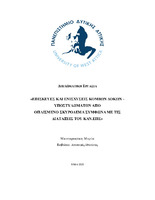| dc.contributor.advisor | Αυτουσμής, Αθανάσιος | |
| dc.contributor.author | Μαστορακάκη, Μαρία | |
| dc.date.accessioned | 2021-12-02T09:17:13Z | |
| dc.date.available | 2021-12-02T09:17:13Z | |
| dc.date.issued | 2021-06 | |
| dc.identifier.uri | https://polynoe.lib.uniwa.gr/xmlui/handle/11400/1607 | |
| dc.identifier.uri | http://dx.doi.org/10.26265/polynoe-1458 | |
| dc.description.abstract | Ένα από τα σημεία ενδιαφέροντος του φέροντος οργανισμού μιας κατασκευής οπλισμένου σκυροδέματος, που παρουσιάζει συχνά προβλήματα χωρίς ωστόσο να λαμβάνει την απαιτούμενη προσοχή, είναι οι κόμβοι σύνδεσης δοκών - υποστυλωμάτων.
Στην Ελλάδα, μέχρι το 1984 όπου ξεκίνησαν να προσδιορίζονται οι πρώτες απαιτήσεις, οι κόμβοι δεν αποτελούσαν αντικείμενο μελέτης και σχεδιασμού. Το γεγονός αυτό αποδείχθηκε επιβλαβές, καθώς πολλές φορές τα κτίρια τα οποία κατασκευάστηκαν με τους κανονισμούς της τότε εποχής, εμφάνισαν σοβαρές αστοχίες στους κόμβους ακόμα και χωρίς την παρουσία σεισμικών φορτίσεων. Πολύ περισσότερο, κατά τους διάφορους σεισμούς που έλαβαν χώρα, η αστοχία των κόμβων ήταν η αιτία κατάρρευσης ολόκληρων κτιρίων. Η εισαγωγή του Κανονισμού Επεμβάσεων (ΚΑΝ.ΕΠΕ) ως εργαλείο μελέτης επισκευής και ενίσχυσης των κτιρίων αποτέλεσε τον πρώτο κανονισμό που έλαβε σοβαρά υπόψη τον ανασχεδιασμό των κόμβων σε υφιστάμενες κατασκευές.
Στην παρούσα εργασία, εξετάστηκαν οι βλάβες των κόμβων ενός διώροφου κτιρίου το οποίο μελετήθηκε και κατασκευάστηκε τις αρχές της δεκαετίας του 1980. Τόσο από το μακροσκοπικό έλεγχο, όσο και από την ανάλυση που πραγματοποιήθηκε με εργαστηριακές μετρήσεις και στατικούς υπολογισμούς, προέκυψε η ανάγκη για ενίσχυση όχι μόνο των κόμβων που εμφανίζουν βλάβες αλλά και των υπολοίπων. Αυτό συμπεραίνεται, καθώς η στατική ανάλυση που πραγματοποιήθηκε σύμφωνα με τις διατάξεις του ΚΑΝ.ΕΠΕ. και με τη βοήθεια του προγράμματος Fespa, έδειξε στατική ανεπάρκεια των κόμβων και άρα αδυναμία ανάληψης των φορτίων του σεισμού σχεδιασμού. Βάσει των προηγούμενων, προτάθηκαν μέθοδοι ενίσχυσης των κόμβων προκειμένου να ικανοποιήσουν τις απαιτήσεις αντοχής του συγκεκριμένου κτιρίου. Οι μέθοδοι που προτάθηκαν, με βασικό κριτήριο την αντοχή και την ασφάλεια, αλλά λαμβάνοντας υπόψη και κριτήρια οικονομικά, λειτουργικά και κατασκευαστικών δυνατοτήτων, ήταν η μέθοδος του μανδύα οπλισμένου σκυροδέματος και η μέθοδος των επικολλητών ελασμάτων. | el |
| dc.format.extent | 115 | el |
| dc.language.iso | el | el |
| dc.publisher | Πανεπιστήμιο Δυτικής Αττικής | el |
| dc.rights | Αναφορά Δημιουργού - Μη Εμπορική Χρήση - Παρόμοια Διανομή 4.0 Διεθνές | * |
| dc.rights.uri | https://creativecommons.org/licenses/by-nc-sa/4.0/deed.el | * |
| dc.subject | Παθολογία κτιρίων | el |
| dc.subject | Κόμβος | el |
| dc.subject | Οπλισμένο σκυρόδεμα | el |
| dc.subject | ΚΑΝΕΠΕ | el |
| dc.subject | Κανονισμός επεμβάσεων | el |
| dc.subject | Μη καταστροφικοί έλεγχοι | el |
| dc.subject | Διάγνωση σφαλμάτων | el |
| dc.subject | Αποτίμηση κτιρίων | el |
| dc.subject | Επισκευές κτιρίων | el |
| dc.subject | Ενισχύσεις κτιρίων | el |
| dc.subject | Fespa | el |
| dc.subject | Ανασχεδιασμός | el |
| dc.title | Επισκευές και ενισχύσεις κόμβων δοκών - υποστυλωμάτων από οπλισμένο σκυρόδεμα σύμφωνα με τις διατάξεις του ΚΑΝ.ΕΠΕ | el |
| dc.title.alternative | Repairs and strengthening of reinforced concrete construction joints | el |
| dc.type | Διπλωματική εργασία | el |
| dc.contributor.committee | Pnevmatikos, Nikos | |
| dc.contributor.committee | Κόκκινος, Φίλης-Τριαντάφυλλος | |
| dc.contributor.committee | Κυριαζόπουλος, Αντώνιος | |
| dc.contributor.faculty | Σχολή Μηχανικών | el |
| dc.contributor.department | Τμήμα Πολιτικών Μηχανικών | el |
| dc.description.abstracttranslated | One of the areas of interest of a reinforced concrete structure that often shows malfunction issues without taking the attention that it should is the beam column joints. In Greece joints where not an aspect of design and calculations up until 1984 when the fisrt preliminary design requirements where established. This fact proved to be harmful, as in many cases buildings constructed with older regulations had serious failures at the joints, even without the presence of seismic loads. Furthermore the failure of joints was a major reason for buildings to collapse during the various earthquakes that have taken place. The introduction of ΚANEPE as a tool for designing repairs and reinforcement of buildings is the first regulation that took seriously into consideration the redesign of joints in existing buildings. In the present study, the damages of the joints of a two storey building designed and constructed in early 1980’s, where examined and analyzed. Both macroscopically as well as through detailed laboratory checks and design calculations, it became clear the need for the reinforcement not only of the obviously deteriorated joints but of the rest joints of the building as well. This conclusion was taken after the static analysis that was conducted based on the regulations and provisions of KANEPE and the use of FESPA software, which proved the design inefficiency of the joints and hence the inability of the structure to carry design seismic loads. Based on the above, reinforcement methods where proposed in order for the joints of the structure to be able to fulfill the design criteria of the specific structure. The methods proposed where reinforced concrete jacketing and steel plates jacketing, and where mainly chosen for the durability and safety of the structure, taking in to account aspects such as economy, construction limitations and functionality constraints. | el |


